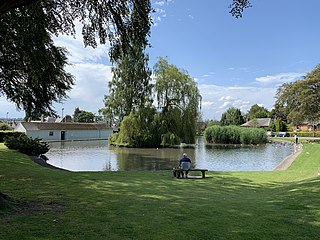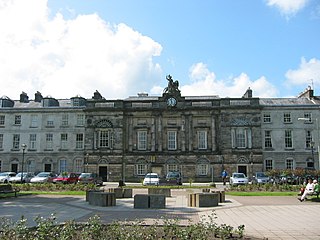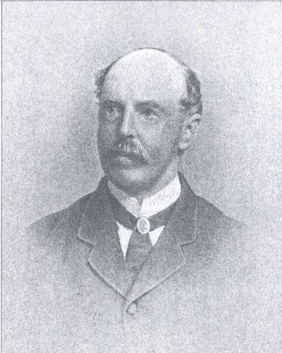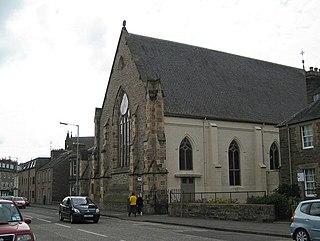
Perth is a centrally located Scottish city, on the banks of the River Tay. It is the administrative centre of Perth and Kinross council area and is the historic county town of Perthshire. It had a population of about 47,430 in 2018.

The Redemptorists, officially named the Congregation of the Most Holy Redeemer, abbreviated CSsR, is a Catholic clerical religious congregation of pontifical right for men. It was founded by Alphonsus Liguori at Scala, Italy, for the purpose of labouring among the neglected country people around Naples. It is dedicated to missionary work and they minister in more than 100 countries. Members of the congregation are Catholic priests and consecrated religious brothers.

The Diocese of Dunkeld is a diocese of the Latin Church of the Catholic Church in southern Scotland. The current bishop of the diocese is, Andrew McKenzie, having been appointed as the diocese’s eleventh bishop, on 27 May 2024.

Kinnoull is a parish in Perth, Perth and Kinross, Scotland, approximately half a mile northeast of Perth city centre. Beginning at the level of the River Tay, which separates the parish from Perth, Kinnoull's terrain continues to rise as it continues southeast, culminating in Kinnoull Hill, the summit of which is at 728 feet (222 m).
The Redemptorists of Australia and New Zealand are a province within The Congregation of the Most Holy Redeemer. The Congregation of the Most Holy Redeemer is a Roman Catholic missionary order which was created in 1732 by Saint Alphonsus Liguori at Scala, near Amalfi, Italy for the purpose of labouring among the neglected country people in the neighbourhood of Naples.
Zynoviy Kovalyk was a Ukrainian Greek Catholic Redemptorist priest and martyr.

St Gerard's Church and Monastery collectively form one of Wellington's most distinctive and iconic landmarks. Located on Mount Victoria in Wellington, both buildings are classified as Category 1 Historic Places by the New Zealand Historic Places Trust. They are built on the site of a sixteen-roomed house and property owned by James Edward Fitzgerald who some claim to be New Zealand's first Prime Minister. In April 2021, the owners of the buildings, the International Catholic Programme of Evangelisation (ICPE), announced that the church would close at the end of the following month due to safety concerns. The buildings were sold to on 27 March 2023. The purchaser was a recently formed company, St Gerard's Limited.

The Municipal Buildings are a municipal facility at Nos. 1, 3 and 5 High Street, Perth, Scotland. The facility is a Category B listed building.

Our Lady of the Annunciation Church is a Catholic parish church next to Bishop Eton Monastery in Childwall, Liverpool. It was built from 1857 to 1858 by the Redemptorists and was designed by E. W. Pugin. It is on the Woolton Road, opposite the Hope Park campus of Liverpool Hope University and close to Our Lady's Bishop Eton Primary School. It is a Grade II* listed building.

The Old Academy is an historic building in Perth, Scotland. Located on Rose Terrace, overlooking the southern end of the North Inch, it is a Category A listed building, built between 1803 and 1807. It was the home of Perth Academy between 1807 and 1932.

Andrew Heiton was a Scottish architect. He designed several notable buildings in Scotland, mostly railway stations and country houses.
Tay Street is a street, part of the A989, in the Scottish city of Perth, Perth and Kinross. Planned in 1806 and completed around 1885, it is named for the River Tay, Scotland's longest river, on the western banks of which it sits. The street runs from the confluence of West Bridge Street and Charlotte Street in the north to a roundabout at Marshall Place and Shore Road in the south. Three of the city's four bridges that cross the Tay do so in this stretch : Perth Bridge, Queen's Bridge and the single-track Tay Viaduct, carrying Perth and Dundee trains to and from Perth railway station, located 0.5 miles (0.80 km) to the north-west.

St John the Baptist Church, also known as St John's Roman Catholic Church, is located in Perth, Perth and Kinross, Scotland. It is a Roman Catholic congregation, based on Melville Street, to the north of the city centre. Completed in 1832, it is now a Category C listed building.

St John the Baptist Church is located in Perth, Perth and Kinross, Scotland. Of Scottish Episcopalian denomination, it is located on Princes Street, at its junction with Canal Street, in the southeastern corner of the city centre. It adjoins the Greyfriars Burial Ground on its western side. Completed in 1851, it is now a Category B listed building. The church's architects were John Hay, William Hardie Hay and James Murdoch Hay, three brothers from Liverpool.

St Andrew's Church is a former church building located in Perth, Perth and Kinross, Scotland. Standing at 19 Atholl Street, one block east of St Ninian's Cathedral, it was completed in 1885 by Robert Brand and Sons builders, the work of Andrew Heiton and his nephew Andrew Granger Heiton. It is now a Category C listed building.
Andrew Granger Heiton was a Scottish architect. He was prominent in the late 19th and early 20th centuries. Several of his works are now listed structures.

Caledonian Road Primary School is a former school building in Perth, Perth and Kinross. Dating from 1892 and made of red sandstone, it is now a Category B listed building. Designed by uncle-nephew duo Andrew Heiton and Andrew Granger Heiton, the building is located at the western edge of Perth's city centre.

Kinnoull Terrace is a street in the Kinnoull parish of Perth, Scotland. A cul-de-sac, it contains five properties, each of which is of listed status and dating from the 19th century. The street was specifically designed, in the mid-19th century, to take advantage of its viewpoint across the River Tay, as was the case with the six villas in Bridgend, a few hundred yards to the north. Noted architectural historian Charles McKean observed that those with "money of the [19th] century jostled for prime sites and views on Dundee Road and Kinnoull Terrace".

Craigievar and Darnick is an historic double villa in Kinnoull, Perth and Kinross, Scotland. Located on Kinnoull Terrace, it is a Category B listed building, built around 1870. The work of architect Andrew Heiton, who lived at the property upon its completion, it is one of five listed properties on the street, denoted by Historic Environment Scotland as items of special interest. Several of the properties appear on maps of Perth from the 1860s.
Redemptorist is a Catholic clerical religious congregation of pontifical right for men. It was founded by Alphonsus Liguori at Scala, Italy.



















